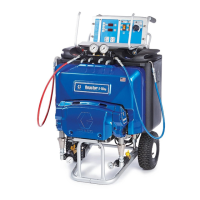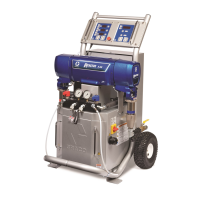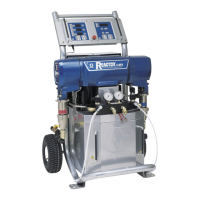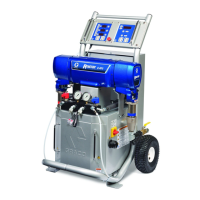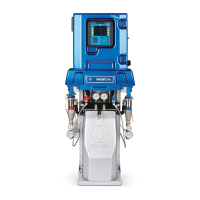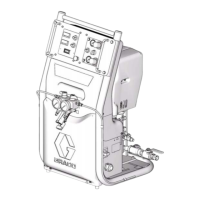Startup of Heated Units
311075R 23
Heatup Guidelines
Slow Recirculation
• Slow Recirc results in a higher temperature
transfer in the heater, so hoses and gun
heat up quicker.
• Good for touchup or low flow spraying, up
to moderate temperature.
• Not used to circulate full tanks up to tem-
perature.
• Use with 245 fa blowing agent foams, to
minimize heat returned to tank and reduce
frothing.
Fast Recirculation
• Fast Recirc keeps heaters on fulltime to
bring fluid tanks up to temperature. The
higher your usage rate, the more heat
needed in the tanks before spraying.
• For normal usage rates: Use Fast
Recirc to get tanks to approximately
50°F (28°C) below desired spray tem-
perature, then use Slow Recirc to raise
hose and gun to desired temperature.
• For higher flow rates or continuous
spraying: Use Fast Recirc to bring tem-
perature of tanks to approximately 20°F
(11°C) below desired spray tempera-
ture, then use Slow Recirc to raise hose
and gun to desired temperature.
• Volume in tanks: Use only what you
need. For example, 2.5 gal. (10 l) in
each tank will heat up almost twice as
fast as 5 gal. (20 l).
• Mixes fluid within tanks, to avoid heating
only the fluid at the top of the tank.
• Use for flushing.
Heat Management Tips
• Heaters perform better with lower flow rates
or smaller mix modules.
• Triggering the gun for short periods helps
maintain efficient heat transfer, keeping
material at the desired temperature. Trig-
gering the gun for a long period does not
allow enough heating time, and cold mate-
rial will enter the hose.
• If temperature displays fall below accept-
able limits, set function knob to Slow Recirc
and circulate again to bring tempera-
tures back up.
• Each 35 ft (10.7 m) hose bundle adds
about 5 minutes to heatup time, with most
materials. Water-based materials take lon-
ger to heat up. Maximum recommended
hose length is 105 ft (32 m).
• Use Fast Recirc until tanks are warm to
the touch, then use Slow Recirc until
displays read desired temperature.
• For a quicker start, do initial heatup circula-
tion with the tanks 1/4 to 1/3 filled, then add
more material.
The fluids must be circulated from the
pumps through the heaters, hoses, and
back to the tanks to ensure warm fluids
are supplied to the gun.
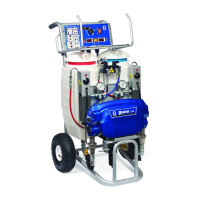
